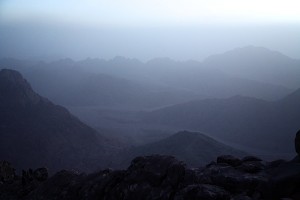Searching for Moses
 The possibility that I might freeze to death in Egypt is not an eventuality that I had considered.
The possibility that I might freeze to death in Egypt is not an eventuality that I had considered.
Egypt=desert=hot is the common assumption, and largely backed by my own experience in 2003 during a scorching expedition through the Sahara.
So you can imagine my surprise when the equation at the foot of Mt. Sinai at 2:00am changed to Egypt=desert=bone-chilling wind that will cut right through you, numb your limbs, and set you shivering like a leaf riding a jackhammer.
Despite my woeful unpreparedness for the cold, the idea was sound: climb the 7,500ft. Mt. Sinai by moonlight and contemplate history from the peak by the magical soft light of sunrise.
Well.
The bitter cold wind aside, the climb was not particularly difficult. For me, or any other reasonably normal person. Guided by a local Bedouin named Mohammed, our little climbing group also included a chain-smoking Argentinian couple who, clearly, probably huffed and puffed and found themselves winded by a trek from their bedroom to their bathroom back at home. A burning bush smoking between their lips, this was their Egyptian Everest.
As we waited at one point for them to wheeze up to us, I looked up on a higher ridge and wished, for the millionth time, that my eyes were a camera. Or, more specifically, one that could export in JPG format directly to my laptop.
There, above us on the edge of a craggy cliff, three camels made their procession along the ridge, completely backlit by a resplendently white full moon directly behind them. The stuff of dreams.
The actual view from the top, sunrise or no sunrise, is nothing to write home about. I can see how a geologist might take pleasure in a landscape of dry, barren, old and crumbly looking rocky peaks, but postcard material this is not. The fact that I feared I might freeze into a human stalagti right there on the peak did nothing to improve it.
No matter. The point of the climb is not visual. It is about history, and religious significance.
Most of us are familiar with the story of Moses:
Hidden as a child when the Pharaoh ordered the death of all Hebrew newborns, Moses’ mother cast him adrift around 1390 BC on a basket on the Nile, where he floated down and was found by the Pharaoh’s daughter. Raised into the royal family as a brother to Ramses (the future Pharaoh), Moses got himself into trouble by killing an Egyptian slave master that was beating a fellow Hebrew.
Moses escaped to the Sinai peninsula and raised sheep for the next forty years. One day, as he was leading his flock around Mt. Sinai (yes, this Mt. Sinai), Moses saw a burning bush, through which God talked to him and told him to go free his (Israelite) people from slavery in Egypt.
The Pharaoh was not swayed by Moses’ request to let his people go or by some of his abilitities (turning his staff into a serpent, changing a river to blood, etc.), so God set loose the ten plagues upon Egypt, including blood, frogs, gnats, flies, diseased livestock, boils, hail and fire, locusts, darkness and finally the death of all Egyptian first-born sons, including the Pharaoh’s (but not the Hebrews’ sons, an event now commemorated by Jews as Passover).
The latter plague finally worked, and the Pharaoh released the Israelite slaves from Egypt in what is now known as the Exodus. The Pharaoh later changed his mind and pursued the Jews with chariots, but Moses parted the Red Sea, allowing the Jews to cross but not the Egyptians. As part of their journey through the desert, Moses returned to Mt. Sinai, where God provided him and the Jewish people with the Ten Commandments, and forty years after they had left Egypt the Jews finally returned to their ancestral home in Israel.
So from that perspective, the geographical visuals on Mt. Sinai pale compared to the religious significance of the location. It is, in fact, a fairly important pilgrimage destination, with a monastery at the foot of the mountain and hundreds of pilgrims from a diverse range of congregations making the climb every day.
There is still ongoing academic debate as to whether Moses was a real historical figure, whether Mt. Sinai is actually the same mountain that is referenced in his story, and the exact circumstances surrounding the Jewish exodus from Egypt. But that is almost beside the point.
Regardless of the actual events some 3,000+ years ago, the fact is that Moses is a common, central figure in three of the five major world religions: Judaism, Christianity and Islam. That means he’s a central tenet of belief for some 5 billion people in the world.
Moses is the greatest prophet in Judaism, mentioned more in Christianity’s New Testament than any other Old Testament figure, and likewise mentioned more often in the Koran than any other individual. It is in fact quite an amazing point of shared belief, especially given how violently these three religions have clashed over the centuries. And perhaps, one day, he will form the basis of a rapprochement (or at least a greater mutual respect) between these same religions.
So while I shivered my way up a ridiculously cold mount (did I mention someone found a handful of snow in the shade of a rock?), lost sensation in my limbs during an uneventful sunrise entirely obscured by clouds, and looked out over rather mundane desert mountain landscape, I also pondered over ancient Egyptian and religious history and marveled at the events that may have happened in this same place thousands of years ago that still help define the shape of our world events today.
 Click to subscribe via RSS feed
Click to subscribe via RSS feed

Wow, this is beautiful.